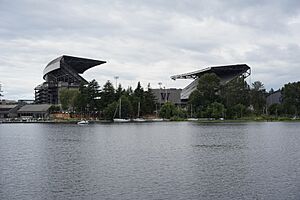Union Bay (Seattle) facts for kids
Union Bay is a body of water located in Seattle, Washington. It is part of Lake Washington. The bay is surrounded by the Laurelhurst neighborhood to the north. To the south are the Montlake and Madison Park neighborhoods. The Evergreen Point Floating Bridge, which carries State Route 520, crosses over a part of the bay.
Marsh Island and Foster Island are found within Union Bay. These islands are connected to the mainland by the Arboretum Waterfront Trail and the Foster Island Trail. Union Bay connects to Portage Bay through the Montlake Cut to the west. This connection marks the start of the Lake Washington Ship Canal, which flows through Seattle and links Lake Washington to Puget Sound.
Broken Island is located next to Husky Stadium. It was formed in 1916 when Lake Washington's water level dropped several feet. This happened after the Lake Washington Ship Canal was opened. The island and its surrounding wetlands were created when shallow lake areas became dry land. The soil on the island is mostly peat, which formed a long time ago.
Contents
History of Union Bay
How the Bay Changed Over Time
In 1916, the water level of Lake Washington dropped by about 9 feet. This was a result of the Lake Washington Ship Canal opening. Because of this, a large part of Union Bay and its marsh and wetland areas became dry land. More land was created through landfill activities from 1911 to 1967.
The Montlake Landfill was used from 1926 to 1967. Today, the University Village shopping center (built in 1956) and most of the east main campus of the University of Washington (UW) sit on this land. Only Husky Stadium was already there. What is left of the Union Bay Marsh is now a restored area within the Union Bay Natural Area at the UW.
Water Flowing In
Union Bay is the outlet for Lake Washington. It also receives water from Arboretum Creek. Another source is Ravenna Creek, which flows through a pipeline from Ravenna Park. This creek is now visible again (daylighted) past the restored Union Bay Natural Area.
Early People of Union Bay
The shores of Union Bay have been lived on for about 10,000 years. This was after the last glacial period ended. The ancestors of today's Native American Duwamish tribe lived here until the 1850s. They were known as the Dkhw’Duw’Absh, meaning "the People of the Inside." They were part of the (Skagit-Nisqually) Lushootseed Coast Salish nations. They had villages around Union Bay.
One village was called hehs-KWEE-kweel, which means "skate." It belonged to the hloo-weelh-AHBSH people. This name came from the narrow passage through the large and resource-rich Union Bay marsh. Parts of this marsh still exist today as the Union Bay Natural Area and the Foster Island area of north Washington Park Arboretum. The trees and the island of Stitici (Stee-tee-tchee) were their special burial ground. Stitici, or Little Island, is now called Foster Island. This village was at the northeast tip of what is now Madison Park. Some of their longhouses were very large homes for many people.
Another important village was SWAH-tsoo-gweel, meaning "portage." This village was on a much larger and plentiful Union Bay. What is now Ravenna was like their backyard before European settlers arrived. The Seattle, Lake Shore and Eastern Railway was built around 1886. It followed the old shoreline where the UW power plant and University Village are today. A longhouse was near the current UW power plant. Other longhouses were around the north shores, which were about a mile farther north than they are today. There were also longhouses east of what is now the Union Bay Natural Area. Villages were spread out.
Cheshiahud, also known as Lake John, and his family were notable residents around Union Bay in Seattle's early years.




